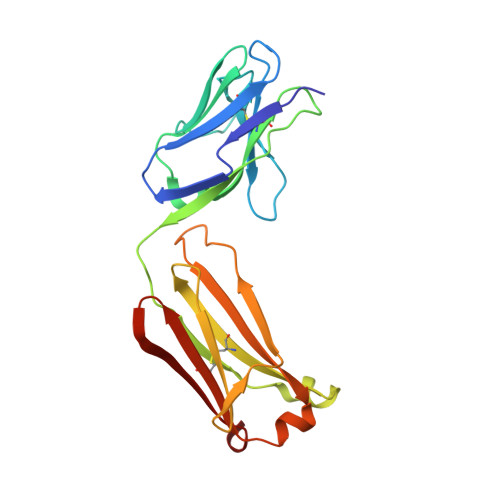In silico Driven Redesign of a Clinically Relevant Antibody for the Treatment of GD2 Positive Tumors.
Ahmed, M., Goldgur, Y., Hu, J., Guo, H.F., Cheung, N.K.(2013) PLoS One 8: e63359-e63359
- PubMed: 23696816
- DOI: https://doi.org/10.1371/journal.pone.0063359
- Primary Citation of Related Structures:
3VFG - PubMed Abstract:
Ganglioside GD2 is a cell surface glycolipid that is highly expressed on cancer cells of neuroectodermal origin, including neuroblastoma, retinoblastoma, melanoma, sarcomas, brain tumors and small cell lung cancer. Monoclonal antibodies (MoAb) that target GD2 have shown clinical efficacy in the treatment of GD2 expressing tumors, and are expected to be the new standard of care for the treatment of pediatric neuroblastoma. In this study, the crystal structure of anti-GD2 murine MoAb 3F8 was solved to 1.65 Å resolution and used as a template for molecular docking simulations of its antigen, the penta-saccharide head group of GD2. Molecular docking revealed a binding motif composed of 12 key interacting amino acid side-chains, involving an extensive network of interactions involving main-chain and side-chain hydrogen bonding, two Pi-CH interactions, and an important charged interaction between Arg95 of the H3 loop with the penultimate sialic acid residue of GD2. Based on in silico scanning mutagenesis of the 12 interacting amino acids from the docked 3F8:GD2 model, a single point mutation (Heavy Chain: Gly54Ile) was engineered into a humanized 3F8 (hu3F8) MoAb and found to have a 6-9 fold enhancement in antibody-dependent cell-mediated cytotoxicity of neuroblastoma and melanoma cell lines. With enhanced tumor-killing properties, the re-engineered hu3F8 has the potential be a more effective antibody for the treatment of GD2-positive tumors.
Organizational Affiliation:
Department of Pediatrics, Memorial Sloan-Kettering Cancer Center, New York, New York, United States of America.















